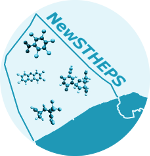NEWSTHEPS project suggests ecological risks due to several chemicals of emerging concern in the Belgian Part of the North Sea
 GhEnToxLab and its partners have recently concluded the NEWSTHEPS project on “New Strategies for Marine Risk Assessment of Chemicals using Passive Samplers”, and the Final report is now publicly available. Our lab was involved in developing a new effect-based monitoring approach using passive samplers for risks assessment and an automated algorithm to calculate predicted no effect concentrations (PNECs), i.e. concentrations for individual chemicals protecting marine ecosystems. Our partners detected pharmaceuticals and personal care products (up to 680 ng/L), steroidal endocrine disruptors (EDCs, up to 104 ng/L) and plastics additives and plasticizers (up to 6500 ng/L). Our lab revealed ecological risks of neonicotinoid insecticides, as well as ecological risks of realistic chemical mixtures extracted from the Belgian Part of the North Sea (BPNS), both in harbors and along the coast. We derived marine PNEC values for 97 chemicals of emerging concern and, by comparison with measured concentrations, we found 21 substances that may cause ecological risks in the BPNS. Among those were 10 steroid EDCs, 5 pesticides, 2 pharmaceutical compounds, 2 phthalates, 1 personal care product, and Bisphenol A. Fifteen of those are currently not on any priority list of the EU and are at risk to escape regulatory action. This may be particularly worrying for fish populations, since these appear to be the most sensitive organisms for most of these substances. Our results suggest that risk reduction related to CECs is urgently needed and our new methods can help delineating priorities. The chemical fate and transport modeling performed in the project indicates that risk reduction will require international policy collaboration, since we have shown that at least the Scheldt, Rhine and Meeuse rivers are likely contributing to CEC pollution in the BPNS.
GhEnToxLab and its partners have recently concluded the NEWSTHEPS project on “New Strategies for Marine Risk Assessment of Chemicals using Passive Samplers”, and the Final report is now publicly available. Our lab was involved in developing a new effect-based monitoring approach using passive samplers for risks assessment and an automated algorithm to calculate predicted no effect concentrations (PNECs), i.e. concentrations for individual chemicals protecting marine ecosystems. Our partners detected pharmaceuticals and personal care products (up to 680 ng/L), steroidal endocrine disruptors (EDCs, up to 104 ng/L) and plastics additives and plasticizers (up to 6500 ng/L). Our lab revealed ecological risks of neonicotinoid insecticides, as well as ecological risks of realistic chemical mixtures extracted from the Belgian Part of the North Sea (BPNS), both in harbors and along the coast. We derived marine PNEC values for 97 chemicals of emerging concern and, by comparison with measured concentrations, we found 21 substances that may cause ecological risks in the BPNS. Among those were 10 steroid EDCs, 5 pesticides, 2 pharmaceutical compounds, 2 phthalates, 1 personal care product, and Bisphenol A. Fifteen of those are currently not on any priority list of the EU and are at risk to escape regulatory action. This may be particularly worrying for fish populations, since these appear to be the most sensitive organisms for most of these substances. Our results suggest that risk reduction related to CECs is urgently needed and our new methods can help delineating priorities. The chemical fate and transport modeling performed in the project indicates that risk reduction will require international policy collaboration, since we have shown that at least the Scheldt, Rhine and Meeuse rivers are likely contributing to CEC pollution in the BPNS.
